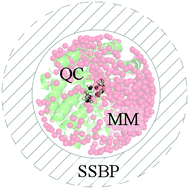Efficient solvent boundary potential for hybrid potential simulations†
Abstract
A common challenge in computational biophysics is to obtain statistical properties similar to those of an infinite bulk system from simulations of a system of finite size. In this work we describe a computationally efficient algorithm for performing hybrid quantum chemical/molecular mechanical (QC/MM) calculations with a

- This article is part of the themed collection: Multiscale modelling

 Please wait while we load your content...
Please wait while we load your content...